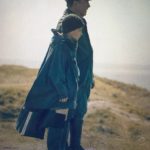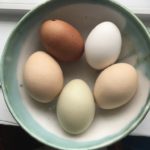




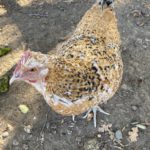

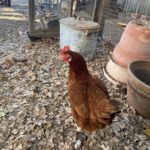





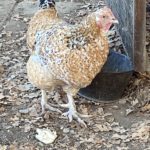






Here we are: of all colors – brown, black, white, light brown, dark brown, orange, sprinkled — of all Shapes – small, big, skinny, voluptuous — of all Characters – independent, aloof, social, cuddly, skeptical, curious, lazy, shy — and of all Ages – from 5 months to more than 5 years and that is pretty old for a chicken, be assured. We all get along fine, except for little fights over special treats and we used to lay those beautiful eggs of all colors but no more. Something happened gradually over several months and by the summer we all had stopped laying eggs. So sad, because the ladies who take care of us tried so hard to get us back on track with special treats – MacDonalds for chickens, they said, and special worms. Really delicious. They took some of us on their lab, patted our feathers, fed us out of their hands but nothing worked. One of the ladies has a little helper, perhaps her granddaughter – you can see her on one of the photos with Ruby. We love that little girl but she didn’t succeed either. No eggs. Yup, thats true. It has been an unusually hard year and I tell you why.
I’M AUDREY


 I’m Audrey — like Audrey Hepburn, you guessed it. I look like her, they say, with the white top hat and the slim, elegant shape. I don’t know Audrey Hepburn, but if she looks anything like me she must have been beautiful. I have been around for about 4 years and most of them with my beloved brother, the rooster in our family of ten. He picked me as his closest companion over all the other beauties in the coop. Good choice. We were an attractive couple, visitors took photos of us all the time. Max, like Maximum, that was his name. He died last winter all of a sudden. No slow ailing into nothingness. Just dead one day lying under the oak tree. I was devastated. Could not lay any eggs anymore. Would run around the garden looking for him. Stopped eating even the special treat that we got more often after Max had died. Perhaps to make us forget our Max but I’m still thinking of him with tears in my eyes. And I still run around looking for him. My closest friends among the chicks, Iris, the black one, and Hilary all in white, keep reminding me to slow down. Hilary and Iris are not really close friends like Max was, but we look good together since our colors match – black and white and grey feet – not yellow like ordinary chickens. It has been almost a year since Max left us and I can’t lay eggs anymore. Every other day I used to lay a perfect snow white egg and would get a special reward from him – he would surprise me by jumping on me and giving me a big big hug. Max, I miss you so much.
I’m Audrey — like Audrey Hepburn, you guessed it. I look like her, they say, with the white top hat and the slim, elegant shape. I don’t know Audrey Hepburn, but if she looks anything like me she must have been beautiful. I have been around for about 4 years and most of them with my beloved brother, the rooster in our family of ten. He picked me as his closest companion over all the other beauties in the coop. Good choice. We were an attractive couple, visitors took photos of us all the time. Max, like Maximum, that was his name. He died last winter all of a sudden. No slow ailing into nothingness. Just dead one day lying under the oak tree. I was devastated. Could not lay any eggs anymore. Would run around the garden looking for him. Stopped eating even the special treat that we got more often after Max had died. Perhaps to make us forget our Max but I’m still thinking of him with tears in my eyes. And I still run around looking for him. My closest friends among the chicks, Iris, the black one, and Hilary all in white, keep reminding me to slow down. Hilary and Iris are not really close friends like Max was, but we look good together since our colors match – black and white and grey feet – not yellow like ordinary chickens. It has been almost a year since Max left us and I can’t lay eggs anymore. Every other day I used to lay a perfect snow white egg and would get a special reward from him – he would surprise me by jumping on me and giving me a big big hug. Max, I miss you so much.
HI I’M IRIS


 So why do I not lay eggs anymore? I can tell you. I don’t like what’s been going on this year. Max disappeared. Audrey, my sometimes companion, got depressed. All our helpers came with a diaper around their face. Couldn’t recognize them anymore and it was hard to understand what they were saying. We used to love to talk to them in the morning when they fed us and cleaned up our poo. They did understand our chicken language – and we their people languages that inspired us, or at least me, to lay a dark brown egg every day. But that changed. With all the turmoil we had to go through I started loosing my precious feathers. I do have a lot of them, not like little Ruby, who really can’t afford losing any. (See this photo with the little helper, I think her name is Tessa.) But you could hardly notice the loss on my big black coat – only I did. And that was in the middle of the summer, not like winter when that usually happens. In any case, that’s why I stopped laying eggs. But let’s listen to Ruby, Pumpkin, Hilary and Copper and the newcomers Sugar and Brownie. They might also shed a bit more light on their sisters’ death shortly after they had joined us. So sad.
So why do I not lay eggs anymore? I can tell you. I don’t like what’s been going on this year. Max disappeared. Audrey, my sometimes companion, got depressed. All our helpers came with a diaper around their face. Couldn’t recognize them anymore and it was hard to understand what they were saying. We used to love to talk to them in the morning when they fed us and cleaned up our poo. They did understand our chicken language – and we their people languages that inspired us, or at least me, to lay a dark brown egg every day. But that changed. With all the turmoil we had to go through I started loosing my precious feathers. I do have a lot of them, not like little Ruby, who really can’t afford losing any. (See this photo with the little helper, I think her name is Tessa.) But you could hardly notice the loss on my big black coat – only I did. And that was in the middle of the summer, not like winter when that usually happens. In any case, that’s why I stopped laying eggs. But let’s listen to Ruby, Pumpkin, Hilary and Copper and the newcomers Sugar and Brownie. They might also shed a bit more light on their sisters’ death shortly after they had joined us. So sad.
Hi, I’M RUBY

 Some people call me Phoenix but ever since little Tessa showed up my name changed to Ruby. I joined the flock some years ago, was handed over the fence by the kids of the nursery school next door. I do like little kids, they hug me, feed me and carry me around like a baby because I was different from the others – smaller, grayer, never laid eggs on a regular basis, only once in a while, and all that made me an outsider to the gang. The big ones, especially Iris and Granny and Copper pushed me away when special goodies were handed out so I relied on my little helper to feed me. Tessa is very concerned about my well being but she did not hand out much of that special “junk food” I liked so much. Why not? I asked her and she said that her mother, one of the caretakers, couldn’t afford buying special treats anymore for the chickens and for her. The virus had made her poor. I wish I could lay an egg every day just for little Tessa. But it doesn’t work. Something stopped a while ago. I’m glad though that I can still be here and hope to spend the rest of my life with Tessa under the big oak tree.
Some people call me Phoenix but ever since little Tessa showed up my name changed to Ruby. I joined the flock some years ago, was handed over the fence by the kids of the nursery school next door. I do like little kids, they hug me, feed me and carry me around like a baby because I was different from the others – smaller, grayer, never laid eggs on a regular basis, only once in a while, and all that made me an outsider to the gang. The big ones, especially Iris and Granny and Copper pushed me away when special goodies were handed out so I relied on my little helper to feed me. Tessa is very concerned about my well being but she did not hand out much of that special “junk food” I liked so much. Why not? I asked her and she said that her mother, one of the caretakers, couldn’t afford buying special treats anymore for the chickens and for her. The virus had made her poor. I wish I could lay an egg every day just for little Tessa. But it doesn’t work. Something stopped a while ago. I’m glad though that I can still be here and hope to spend the rest of my life with Tessa under the big oak tree.
I’M GRANNY

 Even though I’m not the oldest of the bunch but you can see why they gave me that name. I have a beard and hair – or soft down feathers on my feet my chest, my face, like an old rooster. But I’m not a rooster – I assure you – I used to lay eggs but when it got so hot this year and there was nothing but smoke to breathe all day and night I couldn’t lay eggs anymore. I lost a few feathers over the summer but not enough to keep me cool. I’m looking forward to the colder months and will see if the eggs will come back.
Even though I’m not the oldest of the bunch but you can see why they gave me that name. I have a beard and hair – or soft down feathers on my feet my chest, my face, like an old rooster. But I’m not a rooster – I assure you – I used to lay eggs but when it got so hot this year and there was nothing but smoke to breathe all day and night I couldn’t lay eggs anymore. I lost a few feathers over the summer but not enough to keep me cool. I’m looking forward to the colder months and will see if the eggs will come back.
I’M HILARY

 Hilary – as in Hillary Clinton with white suit but only one L . From her I must have inherited my intelligence, grace and beauty and I’m proud of it. If only she had become the president instead of that rude, ugly guy with fake orange hair. I’m not the president of our chicken community – Iris or Audrey came closer to it before the pandemic changed everything. Yes, Corona starting with C divided this year in BC (before) and AC (after) , better would be DC – during Corona – because it is still around. Almost all people visiting us still wear the mask. Why don’t we have to put one on our face? I heard the virus originated from a market place in China where birds spread it to humans. We are birds too. A mask, please!
Hilary – as in Hillary Clinton with white suit but only one L . From her I must have inherited my intelligence, grace and beauty and I’m proud of it. If only she had become the president instead of that rude, ugly guy with fake orange hair. I’m not the president of our chicken community – Iris or Audrey came closer to it before the pandemic changed everything. Yes, Corona starting with C divided this year in BC (before) and AC (after) , better would be DC – during Corona – because it is still around. Almost all people visiting us still wear the mask. Why don’t we have to put one on our face? I heard the virus originated from a market place in China where birds spread it to humans. We are birds too. A mask, please!
I’M COPPER

 I joined the family more than 6 years ago and I became very cosy with whoever is feeding us. I like to sit on our caretaker’s legs – if they have time to sit down at all. Do you like my colors? Brown and light gray almost blue sprinkled into the light brown and a dark brown collar. Like Ruby I like being petted and hugged. I wish it would happen more often but this year during corona times even we chickens – except Ruby – had to stay 6 feet apart from most of the caretakers. Are we and perhaps our eggs carrying the virus too? So better not to lay any eggs to stop the spreading.
I joined the family more than 6 years ago and I became very cosy with whoever is feeding us. I like to sit on our caretaker’s legs – if they have time to sit down at all. Do you like my colors? Brown and light gray almost blue sprinkled into the light brown and a dark brown collar. Like Ruby I like being petted and hugged. I wish it would happen more often but this year during corona times even we chickens – except Ruby – had to stay 6 feet apart from most of the caretakers. Are we and perhaps our eggs carrying the virus too? So better not to lay any eggs to stop the spreading.
I’M PUMPKIN

 Round, orange, with some dark speckles but not ready yet for soup or pumpkin pie – even though I stopped laying eggs. Why, you are asking. Well, the answer is not so simple. I came to the coop about 5 years ago, laid many, many eggs but it stopped. I don’t know why. The virus, the smokey air, the young newcomers who don’t really socialize with me – and then two of them even died. Strange things happened in our coop this year. I think I have done my share of laying eggs and am ready for retirement.
Round, orange, with some dark speckles but not ready yet for soup or pumpkin pie – even though I stopped laying eggs. Why, you are asking. Well, the answer is not so simple. I came to the coop about 5 years ago, laid many, many eggs but it stopped. I don’t know why. The virus, the smokey air, the young newcomers who don’t really socialize with me – and then two of them even died. Strange things happened in our coop this year. I think I have done my share of laying eggs and am ready for retirement.
I’M TUX
 Black and white and that’s it. No other resemblance to those fine guys in tuxedos. I’m always pushed aside in the coop, you see Iris and also Brownie, the latest addition to our family, looking at me as if I don’t belong here – although I have been around for many years – and I’m pretty too, don’t you agree. I think, Pumpkin is right. After having laid many eggs we deserve a comfy retirement. I’m looking forward to it.
Black and white and that’s it. No other resemblance to those fine guys in tuxedos. I’m always pushed aside in the coop, you see Iris and also Brownie, the latest addition to our family, looking at me as if I don’t belong here – although I have been around for many years – and I’m pretty too, don’t you agree. I think, Pumpkin is right. After having laid many eggs we deserve a comfy retirement. I’m looking forward to it.
Part 2 – WHY WE LAY EGGS AGAIN




Hi we are SUGAR and BROWNIE – I’m sure you can figure out who is who. Let’s start with the sad news. We arrived together from a farm close to Yosemite with our beautiful sister COOKIE who got sick and died. The caretakers tried hard to make her feel better with hand-fed goodies, a safe place separate from all the others who attacked poor Cookie – Sugar and I did not. We watched her fade away and hoped that whatever she had would not get us. So scary with this dangerous virus going around. Cookie found a beautiful resting place near by, next to the rooster Max. We did not know him. Cookie was replaced by another Cookie from the same farm near Yosemite and that Cookie also died after a short illness. You see the three stones with flowers, the family grave. Very strange what happened to our Cookies. It must have been the virus but nobody else got it. Sugar and I became strong beautiful women. It took a while to find a comfortable place in our new family of 8 ladies, some of them, especially black Iris, can be very aggressive. And even my sister Sugar lately developed a mean streak attacking me over goodies. But we always end up making peace, go to our nests and lay an egg – every day. Sugar’s is huge, XL, said our caregiver, mine more size M, and lo and behold, even black Iris started laying a dark brown egg again. She would watch me on the nest and when I was done she would sit down right after me in the same warm nest and lay an egg that she then pecked to pieces. What a bummer. It made the nest sticky and uncomfortable but she stopped doing that. The other day the caretaker wrote with big black ink the number 3 on the calendar. Three eggs that day. So, be assured Ladies, better times are ahead. Cheers to 2021!
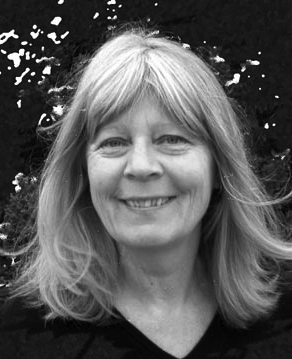






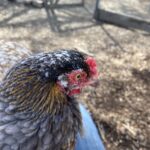

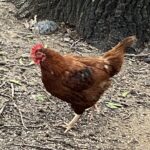
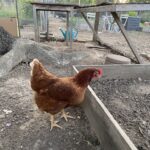








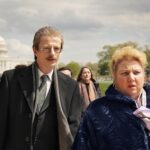
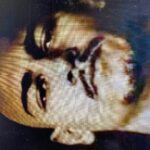





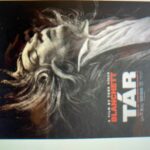
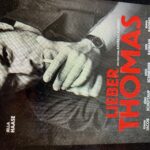


















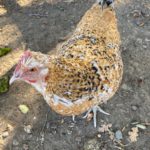
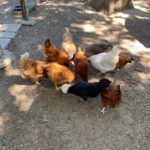















































 T
T

























